Chapter 1: Internet Business Basics
In This Chapter
![]() Understanding the Internet marketing process
Understanding the Internet marketing process
![]() Creating a website plan
Creating a website plan
![]() Knowing who your customers are
Knowing who your customers are
![]() Setting goals for your website
Setting goals for your website
![]() Calculating your website promotion budget
Calculating your website promotion budget
![]() Deciding what to do yourself and when to hire an expert
Deciding what to do yourself and when to hire an expert
If you’re just getting started on the Internet, you may feel like you have a daunting task in front of you. Experienced Internet marketers feel similar stress in that they get so distracted with whatever new technology is released, they lose focus on the core components that have made their businesses thrive for so many years.
The good news for both groups is that the actual process for succeeding online hasn’t changed. Sure, more tools are available online today than there were in 1996, but all of those technological advances have been created to simply help you through the web marketing process.
This chapter is meant for business owners, website designers, programmers, and other providers of Internet services alike. First, you get an overview of today’s Internet marketing process. By understanding the process, you know the right time and sequence of steps to apply any strategy you glean from this book, such as having various website components in place before launching a Google AdWords campaign, or knowing your conversion rates before attempting to recruit affiliates to promote your product. You then assemble a realistic plan that will enable you to use the Internet to its fullest.
Understanding the Internet Marketing Process
Today’s entrepreneur finds success by following a step-by-step process to grow and run his company via the Internet. The following sections outline this process for you.
Step 1: Get in control
The success or failure of your Internet marketing strategy determines whether food appears on your table next month and whether your bills get paid. You must be in control of any process that affects your lifestyle. Basic components you should be in control of include
• Original website design files, including images, photos, and logos: In the event that your designer suddenly becomes unavailable through other employment, discontinued interest in your project, or even death, having access to the originals will allow you to transition easily to another service provider.
• Website hosting logins: Every website needs a website hosting location where all the files are stored and accessed on the Internet. You should always choose your own hosting company and pay for that service directly to the hosting company. Any login usernames and passwords supplied by that hosting company should be in your name and in your control. You might very well provide access to your website to designers, programmers, and Internet marketers, but the only way you’ll have the ability to change passwords in the event you want to change personnel is if you are in charge of your hosting account.
• Backups of all content, pages, and HTML code: In the event that you need to change website hosting companies or if you decide to fire your copywriter or administrative staff who might supply or maintain your website content, always have a current backup of your website’s pages. That way, if your hosting company pulls the plugs on its servers and goes out of business, you could still be up and running with another hosting provider within a matter of hours — if you have good backups of your content. Otherwise, if you don’t have access to those pages, you would need to create all those documents from scratch. Not good.
• Domain name logins and registrations in your name: If the website is the heart of your online efforts, your domain name is the brain. It is the most critical piece of your identity that displays who you are and what your business is about. As the business owner, you must own your domain name, have it registered in your name, and have exclusive rights to maintain it. Never let your designer, administrative assistant, or even your mother register your domain name for you. A domain name such as YourBusinessName.com is tied to the web server where your website resides. If you decide to change hosting companies, the only way to change where the domain name points to is by logging into your domain name registrar (the company where you registered your domain name) and changing the appropriate settings. This is something only you should have control over.
• Additional logins or passwords: Beyond the basic website level, a variety of usernames and passwords will be issued to you. These could include a Google AdWords account, article directory submission logins, visitation statistics reporting access, YouTube video accounts, social networking logins (as presented in Book VII), and third-party e-mail management systems (see Book V), to name a few. When you’re implementing your own Internet marketing campaigns, be sure to have all account registrations in your name, using your e-mail address. That way, you always retain administrative rights to those promotional outlets.
 Try KeePass (
Try KeePass (http://keepass.info), a free tool for storing all your usernames and passwords on your desktop computer. All you have to remember is one main password, and then you’ll have access to them all.
However, if you choose to outsource the more time-intensive Internet marketing functions (such as Google AdWords, as an example), be open to the idea of a professional organization having the exclusive right to that account. After all, there is a great deal of magic that skilled Google AdWords managers will be reluctant to hand over to you should you choose to cut your ties with their services. In cases like these, you really are still in control: That is to say (cough), you are in control of whether you will pay that service provider for additional services next month. Make sure that your service provider supplies you with routine progress reports so that you can make that assessment accurately.
Step 2: Establish your products and services for sale
If you have a business, money needs to eventually transact, or you won’t be in business for long. Part of the Internet marketing process is identifying what products your market wants, how or whether your competition offers anything similar, and what online methods you will use to transact that sale online and deliver the goods. The rest of the chapters in this minibook offer an introduction to strategies that help you accomplish this step.
Step 3: Communicate your solution
Your future customers will visit your website with a problem to solve. And, they’re hoping you have the solution! Before launching any traffic-building campaign, assure that your website provides what your visitors expect to see when they arrive. Test and tweak your graphics, offers, and content to assure that you have the highest potential conversion rate.
See the upcoming section “Create traffic and conversion what-if scenarios” for more about the importance of conversion rates. Book III offers more nitty-gritty details about setting and meeting conversion rate goals.
Step 4: Build traffic to your website
After your website is converting on a small scale, the next step is to increase visitation. This is where press releases, search engine optimization, articles, and podcasting (to name a few campaigns) come into play. Your job is to research each type of traffic generator and decide which outlets are good fits for your budget and desired speed to market. Each minibook in this book provides detailed steps toward implementing the most impactful traffic builders used today on the Internet. Master those first — such as search engine optimization (Book II), pay-per-click advertising (Book III), and social networking (Book VII) — and you will naturally graduate to other traffic-building opportunities over time.
Step 5: Become the recognized expert in your field
People buy online from other people who they know, like, and trust. The web is a tremendous tool for achieving all three, and in a short amount of time, often on a shoestring budget. You become the expert by sharing what you know about your industry. The blog is one of the greatest inventions in recent years for developing a following and becoming a perceived leader in your field. A blog is, by definition, a website like any other. It contains graphics, content, and formatting just like all traditional websites. However, a blog has additional firepower that, if used correctly, can automate almost the entire publicity distribution process for you, giving you the opportunity for near-immediate visibility (see Book VI).
Another essential, and often overlooked or misused, component to becoming a recognized authority in your field involves using e-mail (see Book V).
Step 6: Create a virtual sales force
After you have traffic and proven conversion rates, you can recruit people to promote your products and services to others. These virtual ambassadors (most of whom you will never meet in person) are affiliates.
Step 7: Power-partner with others for exponential sales growth
Also known as a joint venture, power-partnering is similar to having an affiliate program but on a much larger level, both financially and personally. The process involves finding one very special person who’s of high stature in an industry and then convincing that person to recommend your product or service to his very large sphere of influence. The results could mean literally thousands of sales for you within as short as one week’s time.
Moving ahead with the process
The great thing about this Internet marketing process is that it works for every business type, large or small. The unfortunate stories you’ve heard from other business owners about their painful online experiences is probably because they didn’t work the process. That process includes asking for help from people who have demonstrated Internet marketing skills and paying for such services in your annual marketing budget.
Going forward — seeing as how you now know the process — you can probably figure out where your business fits in. Maybe you have plenty of traffic, but your website isn’t converting as many visitors to customers as you want. In that case, go to Step 3 in the process. Or, you’re getting traffic and sales, but you’re experiencing an unusual amount of returns. Go to Step 2 and build a better product or service. Conversely, after you make it through the sequence and you’re now becoming a recognized expert in your field, you want to set your sights on creating an affiliate program because a virtual sales force and ultimately a joint venture opportunity will be right around the corner.
Planning Your Website Strategy
Just as the Internet marketing process is a sequence, developing your online strategy is much the same. For example, you must know your customers and how much they’re willing to spend before you can create goals for how much you can sell. You need to know your own capabilities and interests as well as how much you want to be involved with the mechanics of the project before you can determine your budget.
Placing importance on your website
Authors and marketing educators alike will tell you to stop putting so much emphasis on your website and put all your efforts into social networking. But your website is important, because it’s the only thing you can control. Facebook, Twitter, Google+, and LinkedIn all have the right to pull the plug on your account whenever they feel you’ve breached their terms of service. Instead, you should be using social media to inspire people you connect with to visit your website.
If anything, your website is now so vitally important that it can be thought of as the very heart of everything you do on the Internet, including all of the following:
• Most cost-effective sales vehicle: You can accept orders 24 hours a day, 7 days a week without the need for employees to process the order by phone or in person.
• Ultimate lead generator: Even the smallest businesses can be in competition with the largest companies for attracting new customers worldwide.
• E-mail list builder: Inspiring visitors to give you their e-mail address for something they will get in return (such as a newsletter, a free report, or coupons) allows you the opportunity to make routine contact with prospects so that you can earn their trust over time.
• Publisher: Write or record content of value and push it to thousands of viewers on your social networks automatically.
• Market research spy: Use online tools to find out what your competition is doing to promote products and services on the Internet to help you make your own decisions of how and where to promote.
• Fast market tester: Make changes to prices and sales copy as often as you’d like and the changes happen immediately, usually with no cost associated (unlike print marketing).
• Collections agent: Credit cards are automatically charged at the point of purchase before the product is shipped or services are delivered.
• Communications vehicle: Company developments can be announced to a mass audience within a few hours or even minutes.
• Support department: The Internet offers one person the ability to provide immediate assistance to multiple customers at the same time by displaying FAQs and offering personalized attention with online chat and e-mail support.
• Product delivery truck: The Internet allows new product forms to be developed that require no shipping, such as e-books and MP3 audio downloads.
Defining your target customers and competition
Many business owners create a product first and then try to figure out who they can sell to. This method isn’t optimal, though, because it doesn’t offer a predictable outcome. Always be aware of who needs your product or service and your competition. These are your two keys to success, and you can do much of your research to gain this knowledge on the Internet.
If you already have a website up and running, identifying the most popular groups visiting your website is easy. Just look at the visitation statistics for the pages of your website to see the popular topics your audience is interested in.
However, if you’re just in the development phase of your website, find an industry-specific forum (a web-based discussion board) to find out what questions people are asking about your industry. The most popular topics and discussions in those forums will help you identify most popular needs — and, therefore, the most probable categories of people who will be visiting your website.
1. Document three categories of needs.
At least three main groups of people will always visit your website in search of a solution. For example, if you were a doctor, you could know from history that new patients come to you because they
• Have an insurance change and are forced to find a new doctor
• Aren’t getting their needs met with a former doctor and are looking for someone new
• Are unhappy with the doctor staff or surroundings
2. Identify competition.
Using Google.com, search for specific keyword phrases to see what competition might be present in your area of focus. For example, if you were a doctor with a specialty in dealing with stroke victims, you would want to search Google for stroke doctor, followed by your city or even your state.
3. Spy on your competition by pointing your browser to Quantcast (www.quantcast.com) (see Figure 1-1) and entering the URLs of competing sites in the search box.
Continuing with the doctor scenario, you could look for the following pointed results:
• Average number of visits per month
• Average age
• Percentage of male versus female visitors
4. Estimate revenue potential.
Verify whether enough business exists to make that product worthwhile.
5. Calculate potential market share.
List the number of competitors and potential customers by region.
Developing your website goals and budget
After you’re confident that you have a product or service that’s in demand, you can begin to develop the goals for your website. Here’s a list of what you need to calculate those goals:
• How much profit do you need per month for your business to grow?
• How many new customers do you need each month to achieve that revenue level?
• What is the average sale quantity needed to accomplish your goals?
Figure 1-1: Quantcast reports demographics of your competition.
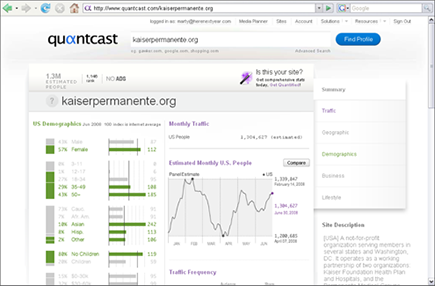
Too often, a business owner will create her operating budget from the ground up. First, she accumulates costs involved with setting up an office. Then, advertising costs are calculated. Business cards and brochures are quoted. At the end of the day, a required monthly sales revenue requirement is generated to assure a certain amount of growth per month or year for a start-up company. This approach is reversed when it comes to using the Internet to build a business. The following sections outline a better process to follow when establishing a budget for web marketing.
Start with your financial goals
Many proven models are available for building businesses online so that you have no reason to “pick numbers out of a hat” any longer. In fact, you can pick virtually any financial number you want to receive per month or per year and have a very close idea of what kind of budget will be required to get you there. Use this formula to determine your own online marketing budget:
1. Determine your desired annual gross revenue.
In other words, decide how much money you want to make by the end of a 12-month period. For this example, use the number that seems to be in everyone’s sights these days: $1 million in gross annual revenue.
2. Calculate your average sales value (ASV).
An average sales value is the total dollars received for all purchases within a given time frame divided by the number of purchases made. It is neither cost related nor profit oriented. Average sale value is simply a number for you to use as a marker to help determine how many overall sales of all products combined you need in the future to reach a desired gross revenue.
You might have only one product or service to sell right now — and that’s okay. You can work on that later! Maybe you’ve been in business for years, with multiple product lines, a variety of pricing, and a number of purchases for each price point per month. In any case, you need an average sale value to work with to determine your Internet marketing budget. For the following example, keep it simple and say that you have an average sale value of $27 for an e-book you created.
3. Project your required sales per day.
Create a basic spreadsheet showing common average sale values and how many sales per year you would need to arrive at $1 million in gross revenue. In the following formula, DR is desired revenue, ASV is average sale value, and SPY is number of sales per year:
DR / ASV = SPY
Continuing with the $27 e-book example, you need 37,037 sales of your e-book over one year’s time; see Figure 1-2. Broken down further, that translates to an average of 3,086 orders per month, or 102 orders per day. Remember that is on average. So, the first few months could be considered ramp-up time during a new product launch phase, and you could still hit that number by the end of the 12 months if you play the numbers.
Figure 1-2: Annual, monthly, and daily sales needed for revenue goal.
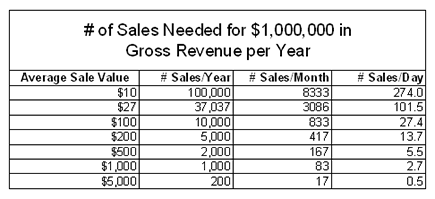
These are simple calculations to make, but sometimes you don’t really see it until you truly see it on paper.
With a better idea of how many sales you’re after per year, month, and day, read on to discover how to calculate the website visitation rate you need to arrive at those numbers.
Create traffic and conversion what-if scenarios
Next, create a similar spreadsheet to show how improving your conversion rates can reduce the amount of traffic you need to make the same revenue as well as the amount of sales per month. (If you’re unfamiliar with conversion rates, refer to the section “Understanding the Internet Marketing Process,” earlier in this chapter.)
To determine your required visitations per month to meet your sales revenue goals, use the following formula, where S is the number of sales you need, C is the conversion rate (which is a percentage), and V is the number of website visitors needed to produce those results:
S / C = V
Adding this formula to a spreadsheet (see Figure 1-3) is not only critical to your creation of a budget and overall Internet marketing plan, but it also enables your ability to dream a bit as well. Although 1 percent is a good starting point and maybe .5 percent is even more realistic as an average, why not triple the number displayed in the sales column or double your conversion rate to see how that reduces the number of visitors you need to acquire? Go ahead; no one is watching. It’s okay to dream!
Figure 1-3: Website visitor traffic needed per month.
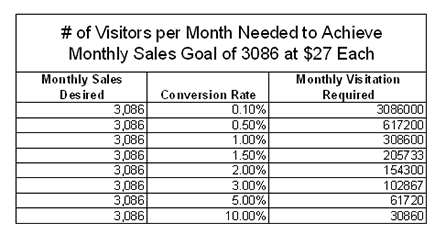
Continuing with the $27 e-book example and the goal of making $1 million in revenue by the end of a year, the formula would look like this:
3,086 / 0.01 = 308,600
Or, in simple language:
3,086 (sales per month) divided by .01 (a 1% conversion rate) = 308,600 visitors needed per month to reach your goal
Here are a few significant insights for analyzing information like this:
• Predictability: You can predict how much revenue your business will see next month — and over the coming months — based on the traffic you generate over just one week’s time.
• Reactivity: When you recognize that visitation decreases suddenly or your conversion rates drop, you have the opportunity to investigate why — and make immediate changes. A shift of even one-quarter of a percentage rate increase or decrease could mean the difference of thousands of dollars.
• Testability: One of the greatest features of the web is that practically anything online can be changed. Gone are the days when you have to pay a designer to build your website once and never get to change anything. Today’s tools allow you to constantly test, tweak, and try new things to increase conversion rates and visitation. You don’t have to wait until you see a severe drop in visitors or sales to do something about it. You can always be working toward increasing those results!
You can easily see the importance of continually monitoring visitation and conversion rates. Such good practices make up the basic fabric from which you make all online promotion decisions going forward.
Book III goes in depth into web analytics tracking setup and strategies.
Calculate how much to spend per visitor
After you determine how many sales you need to meet your goals and how much traffic you need to generate your desired sales volume, the next logical step is to calculate how much money you can afford to spend to get the traffic. You can use a basic spreadsheet to do this job, as shown in Figure 1-4.
Figure 1-4: Expense allowance per visitor.
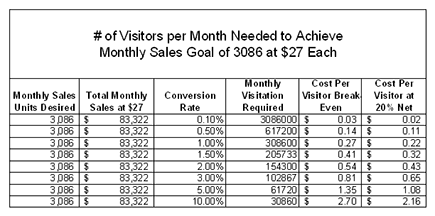
This number is significant for your operating budget process because it allows you to create a specific marketing projection based on predicted results. For example, you could have 20 percent of your budget allocated to organic search engine optimization services, 10 percent toward your continued learning, 50 percent going to Google AdWords, and 20 percent allocated toward offline marketing efforts. Simply change the numbers in the formula to create your own instant what-if scenarios.
Knowing your limits
Many of us start a business because we want to be our own boss: to make all the decisions and be responsible for all functions. By the time the business is up and running, though, you’ve likely discovered just how many decisions need to be made and how many functions you have to do — and how much time they all consume. For example, using the Internet to bring leads and sales to your business can easily be a full-time job for three or four people, let alone you by yourself. Even the most cutting-edge online strategies won’t move forward until you turn the keys in the ignition.
Answer these questions to help you decide how much you want to be involved with the day-to-day operations of a website strategy:
• What are you really, really good at?
• Which skills make sense for you to improve, and for what tasks should you hire someone who already has the necessary skill set?
• What do you enjoy doing that you could do all day long and not require payment?
• What type of work do you absolutely despise?
Use Table 1-1 to rate your ability and willingness to perform the following functions (rank from 1–5, where 1 = low and 5 = high). Then add each line for your total.

For any task where your total is less than 6, it would likely be in your best interest of time to pay someone to perform that role for you. Anything for which you score an 8 or higher, you might find total enjoyment from performing that task on your own. The middle ground offers opportunity for learning and growth.
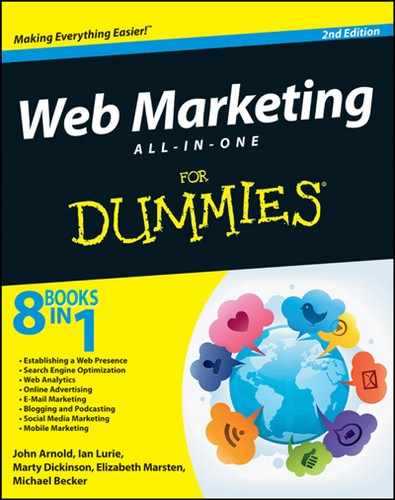
 A
A